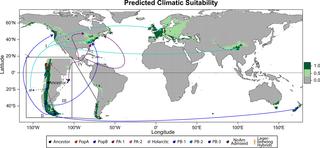当前位置:
X-MOL 学术
›
PLOS Genet.
›
论文详情
Our official English website, www.x-mol.net, welcomes your feedback! (Note: you will need to create a separate account there.)
Postglacial migration shaped the genomic diversity and global distribution of the wild ancestor of lager-brewing hybrids.
PLOS Genetics ( IF 4.5 ) Pub Date : 2020-04-06 , DOI: 10.1371/journal.pgen.1008680 Quinn K Langdon 1 , David Peris 1, 2, 3 , Juan I Eizaguirre 4 , Dana A Opulente 1, 2 , Kelly V Buh 1 , Kayla Sylvester 1, 2 , Martin Jarzyna 1, 2 , María E Rodríguez 5 , Christian A Lopes 5 , Diego Libkind 4 , Chris Todd Hittinger 1, 2
PLOS Genetics ( IF 4.5 ) Pub Date : 2020-04-06 , DOI: 10.1371/journal.pgen.1008680 Quinn K Langdon 1 , David Peris 1, 2, 3 , Juan I Eizaguirre 4 , Dana A Opulente 1, 2 , Kelly V Buh 1 , Kayla Sylvester 1, 2 , Martin Jarzyna 1, 2 , María E Rodríguez 5 , Christian A Lopes 5 , Diego Libkind 4 , Chris Todd Hittinger 1, 2
Affiliation

|
The wild, cold-adapted parent of hybrid lager-brewing yeasts, Saccharomyces eubayanus, has a complex and understudied natural history. The exploration of this diversity can be used both to develop new brewing applications and to enlighten our understanding of the dynamics of yeast evolution in the wild. Here, we integrate whole genome sequence and phenotypic data of 200 S. eubayanus strains, the largest collection known to date. S. eubayanus has a multilayered population structure, consisting of two major populations that are further structured into six subpopulations. Four of these subpopulations are found exclusively in the Patagonian region of South America; one is found predominantly in Patagonia and sparsely in Oceania and North America; and one is specific to the Holarctic ecozone. Plant host associations differed between subpopulations and between S. eubayanus and its sister species, Saccharomyces uvarum. S. eubayanus is most abundant and genetically diverse in northern Patagonia, where some locations harbor more genetic diversity than is found outside of South America, suggesting that northern Patagonia east of the Andes was a glacial refugium for this species. All but one subpopulation shows isolation-by-distance, and gene flow between subpopulations is low. However, there are strong signals of ancient and recent outcrossing, including two admixed lineages, one that is sympatric with and one that is mostly isolated from its parental populations. Using our extensive biogeographical data, we build a robust model that predicts all known and a handful of additional regions of the globe that are climatically suitable for S. eubayanus, including Europe where host accessibility and competitive exclusion by other Saccharomyces species may explain its continued elusiveness. We conclude that this industrially relevant species has rich natural diversity with many factors contributing to its complex distribution and natural history.
中文翻译:

冰后迁移塑造了啤酒酿造杂交种野生祖先的基因组多样性和全球分布。
野生的、适应寒冷的杂交贮藏啤酒酵母亲本 Saccharomyces eubayanus 有着复杂且未被充分研究的自然历史。对这种多样性的探索既可以用于开发新的酿造应用,也可以启发我们对野生酵母进化动态的理解。在这里,我们整合了 200 个 S. eubayanus 菌株的全基因组序列和表型数据,这是迄今为止已知的最大的集合。S. eubayanus 具有多层种群结构,由两个主要种群组成,进一步分为六个亚种群。其中四个亚群仅在南美洲的巴塔哥尼亚地区发现;一种主要分布在巴塔哥尼亚,在大洋洲和北美洲很少见;一个是针对全北极生态区的。植物宿主关联在亚群之间以及 S. eubayanus 与其姐妹物种 Saccharomyces uvarum 之间存在差异。S. eubayanus 在巴塔哥尼亚北部最为丰富,遗传多样性最高,其中一些地方的遗传多样性比南美洲以外的要多,这表明安第斯山脉以东的巴塔哥尼亚北部是该物种的冰川避难所。除了一个亚群外,所有亚群都显示出距离隔离,亚群之间的基因流动很低。然而,有强烈的古代和近期异交信号,包括两个混合的血统,一个与其亲代同域,一个主要与其亲代种群隔离。利用我们广泛的生物地理数据,我们建立了一个强大的模型,可以预测全球所有已知和少数其他气候适合 S. eubayanus,包括欧洲,其他酵母属物种的宿主可及性和竞争性排斥可能解释其持续难以捉摸的原因。我们得出结论,这种与工业相关的物种具有丰富的自然多样性,许多因素促成了其复杂的分布和自然历史。
更新日期:2020-04-06
中文翻译:

冰后迁移塑造了啤酒酿造杂交种野生祖先的基因组多样性和全球分布。
野生的、适应寒冷的杂交贮藏啤酒酵母亲本 Saccharomyces eubayanus 有着复杂且未被充分研究的自然历史。对这种多样性的探索既可以用于开发新的酿造应用,也可以启发我们对野生酵母进化动态的理解。在这里,我们整合了 200 个 S. eubayanus 菌株的全基因组序列和表型数据,这是迄今为止已知的最大的集合。S. eubayanus 具有多层种群结构,由两个主要种群组成,进一步分为六个亚种群。其中四个亚群仅在南美洲的巴塔哥尼亚地区发现;一种主要分布在巴塔哥尼亚,在大洋洲和北美洲很少见;一个是针对全北极生态区的。植物宿主关联在亚群之间以及 S. eubayanus 与其姐妹物种 Saccharomyces uvarum 之间存在差异。S. eubayanus 在巴塔哥尼亚北部最为丰富,遗传多样性最高,其中一些地方的遗传多样性比南美洲以外的要多,这表明安第斯山脉以东的巴塔哥尼亚北部是该物种的冰川避难所。除了一个亚群外,所有亚群都显示出距离隔离,亚群之间的基因流动很低。然而,有强烈的古代和近期异交信号,包括两个混合的血统,一个与其亲代同域,一个主要与其亲代种群隔离。利用我们广泛的生物地理数据,我们建立了一个强大的模型,可以预测全球所有已知和少数其他气候适合 S. eubayanus,包括欧洲,其他酵母属物种的宿主可及性和竞争性排斥可能解释其持续难以捉摸的原因。我们得出结论,这种与工业相关的物种具有丰富的自然多样性,许多因素促成了其复杂的分布和自然历史。


























 京公网安备 11010802027423号
京公网安备 11010802027423号